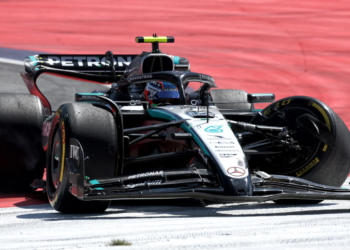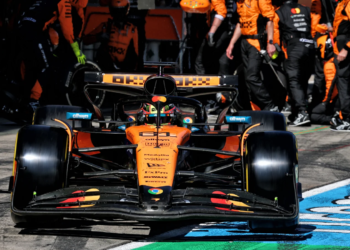Formula 1, like most things, has its unwritten rules to go with its written ones. And aptly the unwritten rules, like the written ones, are there to be broken. The recent Abu Dhabi Grand Prix season closer did just that. As, in something long considered unthinkable, it slipped into the month of December.
Yet the words of Sir Frank Williams are apposite. “It’s tempting to think that recent events are breaking new ground or that they are the end of the world as we know it,” he observes, “when, in fact, there is actually – technical developments aside – absolutely nothing new in this business.”
And there isn’t here. F1 has ventured into December for its year’s finale on three previous occasions too.
The first was almost exactly 60 years ago, something that’s inspired a few retro features in recent days. When Jack Brabham in 1959 pushed his out-of-fuel Cooper to his first title of three drivers’ titles, at Sebring in Florida.
This was on December 12 of that year. And if you ever catch yourself complaining about modern F1 scheduling then consider that this championship showdown race was a day short of three months after the ’59 schedule’s next-to-last round, at Monza.
And the two other examples of December F1 finales are even more extreme. These were in 1962 and ’63 – both were the South African Grand Prix at the scenic East London Prince George circuit next to the Indian Ocean.
Both were not only in December but were in the week between Christmas and New Year. They also were over two months on from the preceding round.
In ’63 Jim Clark had the decency of sparing everyone weeks of tenterhooks awaiting the final round by dominating the year and wrapping up the title well in advance.
But in ’62 all had to wait some two-and-a-half months from the previous race at Watkins Glen on October 7 – and get through their Christmas dinners – before witnessing F1’s crucial championship decider. On December 29 that year.
1962 was a remarkable season in many ways. One with a conspicuous changing of the guard.
The story begins as long previously as the autumn of 1958, and the-then FIA (or, to be precise, CSI) president Augustin Perouse announcing that F1 for 1961 would move from its 2.5-litre engines to a rather puny 1.5, combined with a hefty minimum weight.
The newly-competitive British teams didn’t like this and stamped their feet, assuming their show of power and unity would get the forthcoming change ditched.
Even a resultant breakaway of sorts happened with the InterContinental Formula started in 1962, which stuck roughly to the old rules, though that amounted to five poorly-supported non-championship races in Britain and was quietly forgotten subsequently.
In ’62 all had to wait some two-and-a-half months from the previous race – and get through their Christmas dinners – before witnessing F1’s crucial championship decider. On December 29 that year.
And all the while the governing body didn’t flinch. The 1.5-litre formula became a reality as scheduled in ’61. Ferrari, almost alone, had been preparing while others were politicking. The Scuderia creamed the year with its famous ‘sharknose’ 156.
But in 1962 the flipside awaited. The British teams were by now ready – their engines now had power parity with Ferrari as well as likely better chassis and drivers. And thus F1 experienced its latest British invasion.
And from unlikely sources. BRM and Team Lotus entering the ‘62 season only ever had achieved a single F1 world championship race win apiece. BRM’s Graham Hill indeed had scored but three points in the previous season and finished joint 15th in the drivers’ table. Lotus’s Clark wasn’t much better off in seventh with 11 points.
But they would dominate the 1962 year as well as the rest of the 1.5-litre formula which extended to the end of 1965.
In 1961 the pair had been powered by the rather breathless four-cylinder Coventry Climax stopgap engine, but now powering the Lotus was a Climax V8 producing nearly 190bhp at 8500rpm.
But that was nothing on the change in the chassis. Lotus heralded an F1 revolution by introducing monocoque construction. Taking its cue from aviation as well as some other motorsport forms, the Lotus 25 used the car’s outer skin as its structure rather than the previous spaceframe network of tubes. The monocoque remains standard to this day.
It had several benefits: lightness, torsional stiffness and compactness, with the last of these at the forefront of Lotus kingpin Colin Chapman’s mind as he managed to reduce frontal area by 17%. While in Clark Lotus had a driver without equal.
“The 25 was a perfect tool for Jim, whose uncanny precision was already a hallmark,” notes Peter Windsor.
Lotus heralded an F1 revolution by introducing monocoque construction. It remains standard to this day. It had several benefits: lightness, torsional stiffness and compactness.
Adding to the 25’s advantage, Chapman somehow neglected to inform Lotus customer teams of the monocoque’s benefits when he just beforehand sold them still-spaceframe Lotus 24s for the ’62 season!
BRM meanwhile had been around since 1947 but had mainly spent the time since not living up to expectations. As Hill noted when he joined BRM from Lotus, having fallen out with Chapman, “I remember everyone saying ‘that’s a mistake, you’re joining a losing team’. It was being thoroughly trounced.”
But as luck would have it the outstanding Tony Rudd was already there, and he and Hill well-and-truly clicked and thus began one of F1’s most famous driver-engineer partnerships.
Yet 1962 was a literally a make-or-break year for BRM, as it was under an ultimatum from boss Alfred Owen to either succeed – by which he meant winning at least two grands prix – or fold. The team got it right at exactly the right time.
It was another to benefit from engine improvement. BRM’s very own V8 had undergone considerable development and now shoved out 190bhp at 10,500rpm. There was little to choose between it and the Climax. And the Ferrari for that matter.
Worse for Ferrari, while all this was going on it compromised itself. With some time-honoured internal wrangling. Between the ’61 and ’62 seasons a dispute among its top brass resulted in a wholesale walkout of key Ferrari staff to the ambitious, but ill-starred, ATS operation. Industrial disputes involving Italian metal workers during ‘62 didn’t help either. Ferrari even sat out the season’s final two rounds.
John Surtees was on pole in his Lola-Climax, sharing the three-car front row with Hill and Clark. While the quickest Ferrari, that of reigning champion Phil Hill, was mid-grid, ninth out of twenty. The game had changed.
Hill and Clark gave advance warning of the new landscape by winning two non-championship races apiece (in Clark’s case, still in the Lotus 24) prior to round one proper. Then the grid for the championship season-opener at Zandvoort rammed home the matter.
John Surtees was on pole in his Lola-Climax, sharing the three-car front row with Hill and Clark. While the quickest Ferrari, that of reigning champion Phil Hill, was mid-grid, ninth out of twenty. The game had changed.
It had changed, changed utterly, in another way too. Essentially Ferrari’s only challenger in ’61, and the undoubted driving standard bearer of the age, was in advance suddenly lost to F1. A few weeks prior to Zandvoort, Stirling Moss, competing in Goodwood’s Glover Trophy, had the accident that ended his top-level driving career.
Moss was in fact set to drive a privately-entered Ferrari in ‘62 with Rob Walker, though as things transpired with the uprated sharknose a title push would have been unlikely at least.
The first few rounds suggested 1962 would be open. Graham Hill won at Zandvoort; Bruce McLaren took victory at Monaco in the Cooper; Clark got his freshman win at Spa then Dan Gurney won for Porsche at Rouen.
Yet the fight became Hill vs Clark. Prior to the South African finale the pair sat on three wins each – Hill guaranteeing BRM’s future with win number two of the year at the Nurburgring.
The difference was that Hill finished everywhere and only failed to score once. The Clark-Lotus 25 combination was the class of field but the 25 also was unreliable at this stage, particularly via its ZE gearbox.
The showdown in South Africa summed up his season. Clark stretched clear of Hill by around a second a lap. But at three-quarters’ distance his Lotus suddenly spewed smoke…
Clark had, aside from his trio of victories, only a single fourth place to his name. That was also at the Nurburgring, when he had to fight through from the back after his engine died at the start. He was so preoccupied on a wet day with clearing his misted-up goggles that he forgot to switch his fuel pumps on!
Yet the odd points-scoring system – where only your best five scores of the nine counted – made the title knife-edge nevertheless. Hill heading into the post-Christmas East London season-closer had 39 points to Clark’s 30, with nine points available for a win. Plus the dropped-score situation meant that, whatever Hill did in South Africa, Clark would be champion on countback if he won the race.
Yet the showdown at the South African seaside track summed up his season. Clark took his sixth pole of the campaign, and on a sunny and breezy day smoothly accelerated into the lead from the start. He stretched clear of Hill next up by around a second a lap, being 10 seconds clear after 10 tours. His lead eventually was half a minute.
But at three-quarters’ distance his Lotus suddenly spewed smoke. He maintained his pace for a couple of laps but then, with his oil pressure surging in the corners, he visited the pts and stayed there. It turned out that a small bolt had come loose and caused an oil leak.
This gave Hill the championship there and then and he took the race win too. Indeed he totalled 42 points that year which was only three short of the maximum possible under the scoring system, while BRM bagged what would be its only constructors’ crown.

![Lando Norris and Oscar Piastri [McLaren] celebrate their 1-2 finish at the 2025 F1 Austrian GP](https://www.motorsportweek.com/wp-content/uploads/2025/06/Lando-Norris-Oscar-Piastri-McLaren-F1-2025-1-120x86.webp)

![Lando Norris and Oscar Piastri [McLaren] celebrate their 1-2 finish at the 2025 F1 Austrian GP](https://www.motorsportweek.com/wp-content/uploads/2025/06/Lando-Norris-Oscar-Piastri-McLaren-F1-2025-1-350x250.webp)


